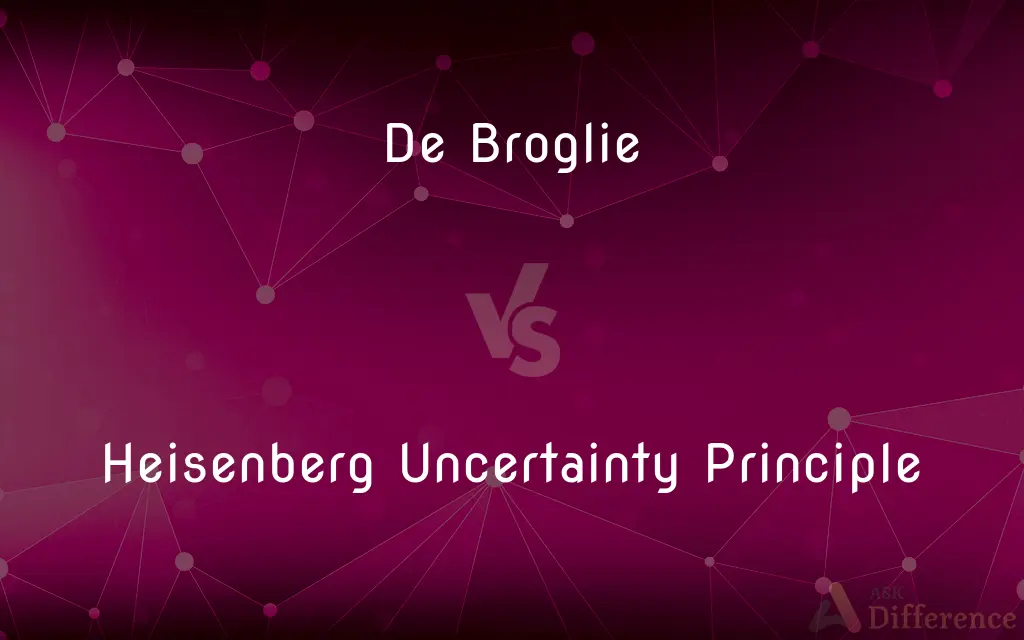De Broglie vs. Heisenberg Uncertainty Principle — What's the Difference?
By Tayyaba Rehman & Urooj Arif — Published on February 17, 2024
De Broglie proposed that particles have wave-like properties, while the Heisenberg Uncertainty Principle states it's impossible to simultaneously know a particle's position and momentum precisely.

Difference Between De Broglie and Heisenberg Uncertainty Principle
Table of Contents
ADVERTISEMENT
Key Differences
The De Broglie hypothesis and the Heisenberg Uncertainty Principle are foundational concepts in quantum mechanics, addressing the wave-particle duality and the limits of measuring quantum systems, respectively. De Broglie introduced the idea that particles such as electrons exhibit wave-like properties, assigning a wavelength to particles based on their momentum. This concept, which bridges classical and quantum physics, suggests that every moving particle has an associated wave, fundamentally altering our understanding of the micro-world.
The Heisenberg Uncertainty Principle, on the other hand, addresses the inherent limitations in measuring quantum systems. It posits that there is a fundamental limit to the precision with which certain pairs of physical properties, like position and momentum, can be simultaneously known. The more precisely one property is measured, the less precisely the other can be determined. This principle challenges the classical notion of determinism and highlights the probabilistic nature of quantum mechanics.
While the De Broglie hypothesis provides a framework for understanding the wave-particle duality of matter, the Heisenberg Uncertainty Principle sets the boundaries for what can be known about a particle's properties at a quantum level. De Broglie's concept is often visualized in phenomena like electron diffraction, which demonstrates the wave nature of particles. In contrast, the Heisenberg Uncertainty Principle is a theoretical limit that underpins the behavior of all quantum systems, influencing everything from the structure of atoms to the principles of quantum computing.
De Broglie's wave-particle duality and Heisenberg's uncertainty principle are complementary, each contributing to the complex portrait of quantum behavior. While De Broglie's hypothesis allows for the prediction of wave behavior in particles, Heisenberg's principle introduces a fundamental unpredictability to their precise characteristics when measured. Together, these concepts demarcate the revolutionary shift from classical physics to quantum mechanics, emphasizing the complex and counterintuitive nature of the quantum world.
In essence, while De Broglie's hypothesis enriches our understanding of particle behavior by introducing wave characteristics, the Heisenberg Uncertainty Principle delineates the limits of our knowledge about these particles, encapsulating the essence of quantum indeterminacy and the probabilistic nature of quantum states.
ADVERTISEMENT
Comparison Chart
Concept
Wave-particle duality of matter
Fundamental limit to precision of measurements
Key Proposition
Particles have wave-like properties
Cannot precisely know position and momentum
Primary Impact
Altered understanding of particle behavior
Introduced fundamental uncertainty in quantum mechanics
Experimental Validation
Electron diffraction experiments
Quantum mechanics experiments, e.g., electron microscopy
Implication
Predictive wave behavior in particles
Limits on the determinism of quantum systems
Compare with Definitions
De Broglie
Bridges classical and quantum physics.
De Broglie's hypothesis was a pivotal shift towards understanding quantum mechanics.
Heisenberg Uncertainty Principle
Introduces indeterminacy to physics.
Heisenberg's principle was groundbreaking, suggesting the universe operates on probabilities.
De Broglie
Proposes particles have associated waves.
The De Broglie wavelength of an electron calculates its wave-like behavior.
Heisenberg Uncertainty Principle
Implies nature's inherent unpredictability.
Quantum mechanics, guided by Heisenberg's principle, embraces the unpredictability of particles.
De Broglie
Assigns wavelength to moving particles.
According to De Broglie, even a baseball has a wavelength, albeit extremely small.
Heisenberg Uncertainty Principle
Fundamental to quantum theory.
The Heisenberg Uncertainty Principle underpins many quantum mechanical phenomena.
De Broglie
Integral to quantum mechanics foundation.
De Broglie laid the groundwork for the wave-particle duality concept.
Heisenberg Uncertainty Principle
Limits precise knowledge of quantum properties.
The Heisenberg Uncertainty Principle explains why exact electron paths are indeterminable.
De Broglie
Demonstrated by electron diffraction.
Electron beams diffracting through crystals confirm De Broglie's theory.
Heisenberg Uncertainty Principle
Affects measurement of position and momentum.
Measuring an electron's position more accurately increases uncertainty in its momentum.
Common Curiosities
Can De Broglie's wavelength be observed in everyday objects?
In theory, yes, but in practice, the wavelengths are too small to be observable.
What is a practical application of the Heisenberg Uncertainty Principle?
It has implications for the design and interpretation of quantum computing and cryptography.
How does the Heisenberg Uncertainty Principle affect determinism?
It challenges classical determinism, suggesting that at a quantum level, events are inherently probabilistic.
How was De Broglie's hypothesis confirmed?
Through experiments like electron diffraction that showed wave-like interference patterns.
What fields of study does De Broglie's hypothesis impact?
Quantum mechanics, particle physics, and nanotechnology.
How does the Heisenberg Uncertainty Principle impact quantum physics?
It introduces a fundamental limit to what can be known about a system's state.
What led to the development of De Broglie's hypothesis?
The observation of wave-particle duality in light and the search for a unified physical theory.
How do researchers utilize the Heisenberg Uncertainty Principle in experiments?
It guides experimental design and interpretation, especially in measurements at quantum scales.
What does the De Broglie hypothesis imply?
It implies that all matter exhibits both particle and wave properties.
Does the Heisenberg Uncertainty Principle apply to macroscopic objects?
While it applies universally, its effects are negligible and unobservable at macroscopic scales.
How do De Broglie wavelengths vary with particle velocity?
The wavelength decreases as the velocity (and thus momentum) of a particle increases.
Can the Heisenberg Uncertainty Principle be overcome?
No, it is a fundamental property of quantum systems, not a limitation of measurement technology.
Is the Heisenberg Uncertainty Principle a theoretical or empirical principle?
It is a theoretical principle with empirical implications, validated by quantum experiments.
What does De Broglie's hypothesis say about non-moving particles?
Non-moving particles have an infinite wavelength, which is a conceptual way to say the wave aspect is not observable.
What implications does the De Broglie hypothesis have for the classical understanding of reality?
It blurs the lines between waves and particles, suggesting that classical distinctions may not hold at quantum scales.
Share Your Discovery

Previous Comparison
Allosteric Enzymes vs. Non-Allosteric Enzymes
Next Comparison
DNA Transposons vs. RetrotransposonsAuthor Spotlight
Written by
Tayyaba RehmanTayyaba Rehman is a distinguished writer, currently serving as a primary contributor to askdifference.com. As a researcher in semantics and etymology, Tayyaba's passion for the complexity of languages and their distinctions has found a perfect home on the platform. Tayyaba delves into the intricacies of language, distinguishing between commonly confused words and phrases, thereby providing clarity for readers worldwide.
Co-written by
Urooj ArifUrooj is a skilled content writer at Ask Difference, known for her exceptional ability to simplify complex topics into engaging and informative content. With a passion for research and a flair for clear, concise writing, she consistently delivers articles that resonate with our diverse audience.














































